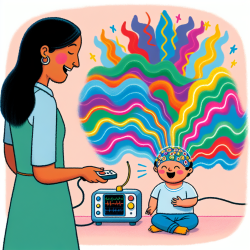Introduction
In the evolving field of speech-language pathology, transcranial direct current stimulation (tDCS) has emerged as a promising tool for enhancing language therapy outcomes in individuals with neurodegenerative anomia. This blog post delves into the findings of the research article titled "Maximizing the Treatment Benefit of tDCS in Neurodegenerative Anomia," which explores the efficacy of tDCS in improving picture naming abilities in patients with anomic Alzheimer's Disease and Frontotemporal dementia.
Understanding tDCS and Its Application
tDCS is a non-invasive brain stimulation technique that applies a low level of electrical current to the scalp, aiming to modulate neuronal activity. The study employed a double-blind cross-over design with twelve participants undergoing picture naming training across ten sessions, coupled with tDCS to specific brain regions.
Key Findings
- Improvement in Naming Abilities: The study found significant improvements in picture naming for both trained and novel items when real tDCS was applied compared to sham stimulation. The parieto-temporal montage showed sustained benefits two weeks post-stimulation.
- Montage-Specific Outcomes: The parieto-temporal montage proved more effective than the dorsolateral prefrontal cortex (DLPFC) montage, especially for novel items, highlighting the importance of targeting specific brain regions.
- Diagnosis-Specific Effects: Participants with semantic variant Primary Progressive Aphasia (PPA) showed less improvement, suggesting that tDCS efficacy may vary based on the underlying neurodegenerative condition.
Implications for Practitioners
For practitioners in speech-language pathology, these findings underscore the potential of integrating tDCS into language therapy regimens. The study suggests that the choice of montage and understanding of patient diagnosis are crucial for maximizing treatment benefits. Practitioners are encouraged to consider these variables when designing therapy protocols.
Encouraging Further Research
While the study provides valuable insights, it also opens avenues for further research. Future studies could explore the long-term effects of tDCS, optimal stimulation parameters, and its applicability across different neurodegenerative conditions. Practitioners are encouraged to contribute to this growing body of research to refine and enhance therapeutic strategies.
Conclusion
The study "Maximizing the Treatment Benefit of tDCS in Neurodegenerative Anomia" offers compelling evidence for the use of tDCS in language therapy. By leveraging data-driven insights, practitioners can enhance therapy outcomes and contribute to the development of effective interventions for individuals with neurodegenerative anomia.
To read the original research paper, please follow this link: Maximizing the Treatment Benefit of tDCS in Neurodegenerative Anomia.










